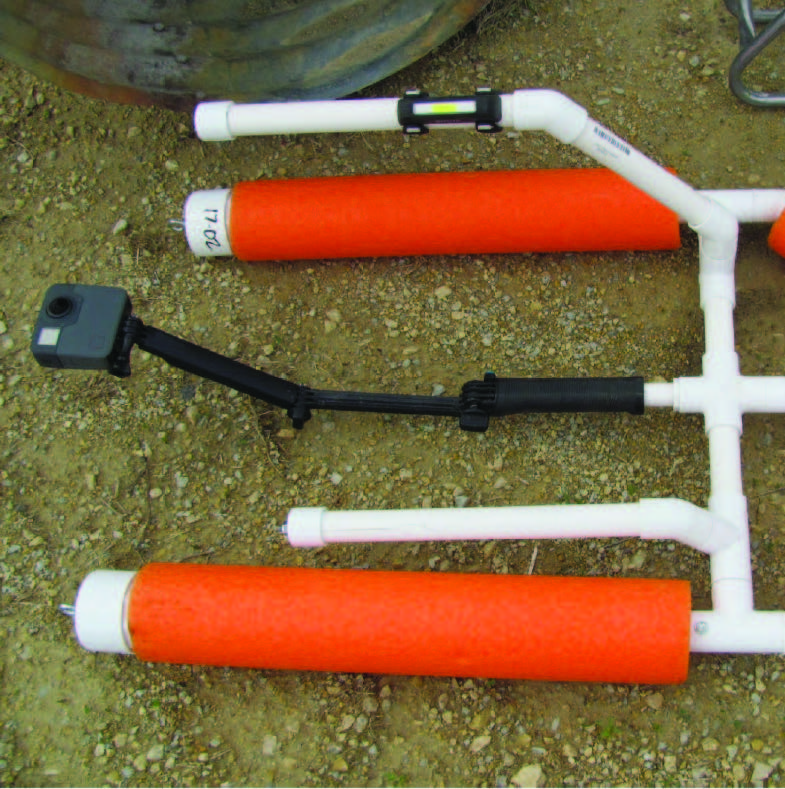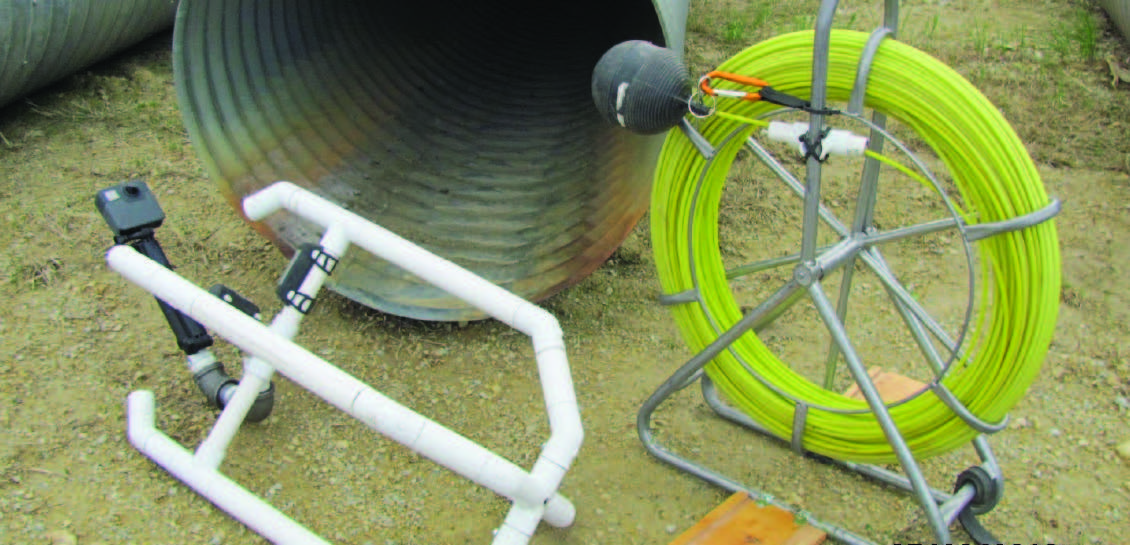Imagine you’re a public works inspector whose job is to check on the condition of culverts. The only way to see inside those culverts is to crawl in with a flashlight. If you’re lucky, the diameter is large enough to get through on your knees. Otherwise, you’re forced to slide in on your belly and roll onto your back. The bottom is wet and often covered in layers of mud.
Senior transportation specialist Jeff Busch doesn’t have to imagine any of that because it’s his reality—at least it was before his resourcefulness led him to a brilliant new solution. Until recently, every time Busch and his fellow Olmsted County, Minnesota, inspectors checked one of 1,600 culverts after a flooding event or before a repair project, they were confronted with uncomfortable, unsanitary, and potentially unsafe conditions.
“If something goes wrong, you’re stuck in that confined space,” says Busch. “It’s an emergency situation.”
The possibility of coming face to face with a rodent or snake provided even more motivation to find an alternative inspection method.
For about two years, the five Olmsted inspectors and their supervisor, Scott Holmes, talked about how they could create a remote inspection system. Busch knew he wanted to design a system without complex wiring, servos (a power-driven mechanism that supplements the primary control), or the need to maintain a Wi-Fi signal. While the team members originally considered using a remotecontrol car to move a camera through the culvert, Busch ultimately led them to the original concept of a camera on a sled.
As a lifelong tinkerer with a childhood habit of taking toys apart to “make them better,” innovative thinking comes naturally to Busch. Presented with this challenge, his gears couldn’t help but turn: If they integrated a 360-degree action camera in their design, they could easily view a culvert from every angle. Plus, he realized most of the models available were waterproof—perfect for their purposes. Applying additional criteria of short focal length, small size, large memory, and viewing and editing software to his search, he found the ideal 360-degree action camera and a tablet that enables the remote use of a live feed.
Busch, however, prefers to review footage back in the office later, finding that immediate answers are not essential, and recordings can be saved as part of the inspection.
To make a model of the sled platform he envisioned for the action camera, he headed for his son’s creative construction set for kids—and it was that prototype composed of little plastic rods and connectors that Busch pitched to Olmsted’s county engineer, Kaye Bieniek, getting her support.
Next, he needed to find a way to move the camera through the culvert. The perfect ingredient came in the form of 4 mm fiberglass fish tape, typically used by electricians to route new wiring, which could be pushed through the pipe and locked into the sled when it got to the other side. A toilet tank float was ideal at the end of the fish tape to help it skip through the pipe without getting stuck.
Busch has been stopped only twice after sending his sled through roughly 120 culverts. And despite pulling his sled over rocks, rusted metal, and even a deer skull, there hasn’t been a single flip-over or wreck. Pretty impressive for something composed of a PVC pipe sled, pool noodle side arms for buoyancy, rechargeable bike lights to illuminate the action camera, a flashing pet collar for visual location, a toilet tank float, and a kite reel that operates as a “positioning yo-yo” or recovery line.
“I’ve never built anything like this,” Busch says. “I just kind of looked for objects that would fit my needs and saw what would work best.”
Before his innovation, the smallest culvert inspectors could enter was 24 inches—and they couldn’t get quality visual documentation for their evaluations. Now, inspectors can obtain clear images in culverts as small as 15 inches. The new system has already provided maintenance crews with better data; in one instance, preventing a road from being torn up when Busch’s video revealed that only a patch was required.
“You can look at video multiple times and get a different view every time,” Busch reports. He was initially concerned about the lens being too close to the pipe for clear images, but that hasn’t been an issue. He does slow videos down to half speed for better resolution, however.
Holmes is impressed with how the 360-degree action camera on skids has transformed their work, not to mention Busch’s ingenuity. “It’s nice having an innovator like Jeff,” he says. “You can go back and look at all these still pictures around the whole culvert—around the top, around the sides, around the bottom. You can spend a half-hour looking at it in the office, and he only ran it through there for a minute.”
Busch says he was going for “cheap but effective,” which he accomplished with his final tally of $1,240, compared to commercial pipe inspection crawler robots that can cost as much as $10,000. The bulk of that cost went toward the 360-degree action camera ($600) and tablet ($360).
Busch has already modified his original design and is now using a third, more compact version featuring even greater stability and flotation capabilities. He also plans to use the 360-degree action camera to get a better view of trouble spots in other areas of his work, including construction and bridge inspections. Culverts are only the beginning.
“I’m definitely inspired to do more,” he says.
For more information contact:
State: Minnesota
Local Agency: Olmsted County Public Works
Names: Jeff Busch, Scott Holmes
Position: Senior Transportation Specialist, Transportation Supervisor
Telephone: 507-328-7070
Email: busch.jeff@co.olmsted.mn.us

©2019 Olmsted County Public Works, Minnesota.

©2019 Olmsted County Public Works, Minnesota.
Find a Center
Alabama Transportation Research Institute
1301 Shelby Center
Auburn University, AL 36849
800.446.0382
http://eng.auburn.edu/atap/
Alaska DOT and Public Facilities Local Training & Assistance Program
PO Box 112500
3132 Channel Drive
Juneau, Alaska 99811-2500
907-465-3900
https://dot.alaska.gov/ltap/
Arizona Local Technical Assistance Program (LTAP)
1130 North 22nd Avenue
Phoenix, AZ 85009
602.712.4050
https://www.azltap.org/
Arkansas Local Technical Assistance Program
700 W Research Center Blvd.
Fayetteville, AR 727701
479-575-3997
https://cttp.uark.edu/technology-transfer/index.php
California Local Technical Assistance Program
Center for International Trade & Transportation California State University, Long Beach
6300 State University Drive, Suite 255
Long Beach, CA 90815
https://www.caltap.org
Colorado Local Technical Assistance Program
Front Range Community College
4616 S. Shields St. LBP 144
Fort Collins, CO 80526
970.204.294
http://www.coloradoltap.org
Connecticut Training and Technical Assistance Center
University of Connecticut
270 Middle Turnpike, Unit 5202
Storrs, CT 06269-5202
860.486.5400
https://t2center.uconn.edu/
Delaware T2 Center
355A DuPont Hall
University of Delaware Newark, DE 19716
302.831.6241
https://sites.udel.edu/dct/t2-center/
Florida Local Technical Assistance Program (LTAP) Center
Center for Urban Transportation Research (CUTR) University of South Florida
4202 E. Fowler Avenue, CUT100
Tampa, FL 33620
813.974.4450
https://floridaltap.org/
Georgia Department of Transportation LTAP Center
3993 Aviation Circle
Atlanta, GA 30336
404.507.3437
https://www.dot.ga.gov/gdot/pages/ltap.aspx
Hawaii Local Technical Assistance Program (LTAP)
Aliiaimoku Building
869 Punchbowl Street
Honolulu, HI 96813
https://hidot.hawaii.gov/highways/other/hawaii-local-technicalassistance-program
Local Highway Technical Assistance Council
3330 W. Grace Street
Boise, ID 83703
208.344.0565
https://lhtac.org/
Illinois Technology Transfer Center
Illinois Department of Transportation
2300 South Dirksen Parkway, Room 208
Springfield, IL 62764
217.720.2300
http://idot.illinois.gov/ transportation-system/local-transportationpartners/county-engineers-and-local-public-agencies/technologytransfer-center/index
Indiana Local Technical Assistance Program (LTAP)
Purdue University
1281 Win Hentschel Blvd, Suite 2111
West Lafayette, IN, 47906
765.494.2164
https://www.purdue.edu/inltap
Iowa Local Technical Assistance Program
Institute for Transportation
2711 S. Loop Drive, Suite 4700
Ames, IA 50010
515.294.8103
https://iowaltap.iastate.edu/
Kansas Local Technical Assistance Program (LTAP)
University of Kansas
M2SEC
1536 W 15th Street, Suite G520
Lawrence, KS 66045
785.864.5658
http://kutc.ku.edu/ltap
Kentucky Technology Transfer (T2) Program
College of Engineering
176 Raymond Building
Lexington, KY 40506
800.432.0719
https://www.kyt2.com/
Louisiana Local Technical Assistance Program
LTRC Training and Education Facility Building
4099 Gourrier Avenue
Baton Rouge, LA 70808
www.louisianaltap.org
Maine Department of Transportation
16 Statehouse station
Augusta, ME 04333-0016
1.800.498.9133
https://www.maine.gov/dot/programs-services/cslr/mlrc
Maryland Transportation Technology Transfer Center (MD T2 Center)
University of Maryland
Maryland Transportation Technology Transfer Center
Technology Ventures Building (806)
5000 College Avenue, Suite 2219
College Park, MD 20742-3021
240.304.9627
http://www.mdt2center.umd.edu/home
Baystate Roads LTAP
UMass Transportation Center
University of Massachusetts
Hampshire House
Room 316
131 County Circle
Amherst, MA 01003
413.545.2604
https://www.umasstransportationcenter.org/umtc/baystate_roads.asp
Michigan Local Technical Assistance Program
Center for Technology & Training
Michigan Technological University
309 Dillman Hall
1400 Townsend Drive
Houghton, MI 49931
906.487.2102
http://www.michiganltap.org/
Center for Transportation Studies
University of Minnesota
University Office Plaza, Suite 440
2221 University Avenue SE
Minneapolis, MN 55414
612.626.1077
https://mnltap.umn.edu
Mississippi Local Technical Assistance Program
Mississippi Department of Transportation
401 North West Street
Jackson, MS 39201
601.359.7685
https://mdot.ms.gov/portal/ltap/
Missouri S&T
710 University Drive, Suite 121
Rolla, MO 65401
573.341.6155
https://mltrc.mst.edu/moltaphome/
Montana State University
2327 University Way, Room 230
Bozeman, MT 59715
406.531.1142
http://www.montana.edu/ltap
University of Nebraska – Lincoln
650 J Street, Suite 215 A
Lincoln, NE 68508
402.472.5748
https://www.ltap.unl.edu/neltap/default.asp
Airport Plaza Office Building
1755 E. Plumb Lane, Suite 264
Reno, NV 89502
775.420.4811
https://nvltap.com/
UNH Technology Transfer Center
Technology Transfer Center
35 Colovos Rd., Gregg #111
Durham, NH 03824
(603) 862-1362
https://t2.unh.edu
Center for Advanced Infrastructure and Transportation Rutgers
The State University of New Jersey
100 Brett Road
Piscataway, NJ 08854
848.445.2906
https://cait.rutgers.edu/njltap/
New Mexico LTAP
New Mexico Department of Transportation
P.O. Box 1149
Santa Fe, NM 87504
505.277.0767
https://ltap.unm.edu
Cornell Local Roads Program
416 Riley-Robb Hall
Ithaca, NY 14853
607.255.8033
www.nysltap.org
North Carolina
909 Capability Drive
Centennial Campus Research Building IV
Mailing Address:
Campus Box 8601
Raleigh, NC 27695
919.515.3983
https://itre.ncsu.edu/focus/ltap/
North Dakota Local Technical Assistance Program
Upper Great Plains Transportation Institute
North Dakota State University
608 E Boulevard Ave
Bismarck, ND 58505
701.224.3826
https://www.ndltap.org/
Ohio LTAP Center
1980 W. Broad Street, Mail Stop #3180
Columbus, OH 43223
877.800.0031
https://www.transportation.ohio.gov/programs/ltap/ltap
Oklahoma Local Technical Assistance Program
Oklahoma State University
5202 N Richmond Hill Rd
Stillwater, OK 74075
405.744.7496
http://ltap.okstate.edu/
Oregon Technology Transfer Center
ODOT Mill Creek Building
555 13th Street NE
Salem, OR 97301
503.986.2855
https://www.oregon.gov/odot/programs/t2/pages/default.aspx
PennDOT Local Technical Assistance Program
PA Department of Transportation
Bureau of Planning and Research
400 North Street, 6th Floor
Harrisburg PA 17120
1800.367.5827
https://gis.penndot.gov/ltap/
Puerto Rico Transportation Technology Transfer Center
University of Puerto Rico at Mayaguez Civil Engineering
and Surveying Department
P.O Box 9000
Mayaguez, PR 00681
787.834.6385
https://prltap.org/eng/
RI Local Technical Assistance Program (RI LTAP)
Rhode Island Department of Transportation
Two Capitol Hill
Providence, RI 02903
401.222.2450
http://www.dot.ri.gov/about/riltap.php
South Carolina Local Technical Assistance Program
Clemson University
Glenn Department of Civil Engineering
202 Hugo Drive Clemson, SC
29634
864.656.4183
https://www.scltap.org/
South Dakota Local Transportation Assistance Program
South Dakota State University
Jerome J. Lohr College of Engineering
1151 8th Street
Brookings, SD 57007
605.688.4121
https://www.sdstate.edu/jerome-j-lohr-engineering/sd-local-transportation-assistance-program
Tennessee Transportation Assistance Program
University of Tennessee – Knoxville Center for Transportation Research
Tickle College of Engineering
309 Conference Center Building
600 Henley Street
Knoxville, TN 37996
865.974.5255
https://ttap.utk.edu
Texas Local Technical Assistance Program
The University of Texas Arlington Extension & Extended Campus
140 W. Mitchell Street
Arlington, TX 76010
817.272.2581
https://www.txltap.org
Utah Local Technical Assistance Program
Utah State University
4111 Old Main Hill
Logan, UT 84322
435.797.2931
https://engineering.usu.edu/cee/transportation/ltap-dev/
Vermont Local Technical Assistance Program Center
2178 Airport Road
Barre, VT 05641
802.828.3537
https://localroads.vermont.gov/
UVA Transportation Training Academy
University of Virginia Center for Transportation Studies
Thornton Hall
Suite B122
151 Engineers Way
P.O. Box 400747
Charlottesville, VA 22904
434.982.2897
http://uva-tta.net/
Washington State Local Technical Assistance Program
310 Maple Park Avenue SE
Olympia, WA 98504
360.705.7355
https://wsdot.wa.gov/business-wsdot/support-local-programs/ local-programs-training
West Virginia Local Technical Assistance Program
395 Evansdale Dr, Rm 651A
P.O. Box 6103
Morgantown, WV 26506
304.293.9924
https://www.wvltap.org/
Wisconsin Local Technical Assistance Program
Fluno Center
601 University Ave 3rd Floor
Madison, WI 53715
800.442.4615
https://ltap.engr.wisc.edu/
Wyoming Technology Transfer Center
University of Wyoming
1000 E University Ave, Dept 3295
Laramie, WY 82071
307.766.6743
http://www.uwyo.edu/wyt2